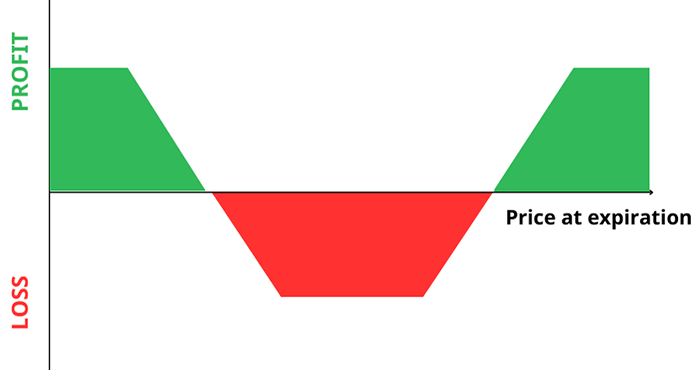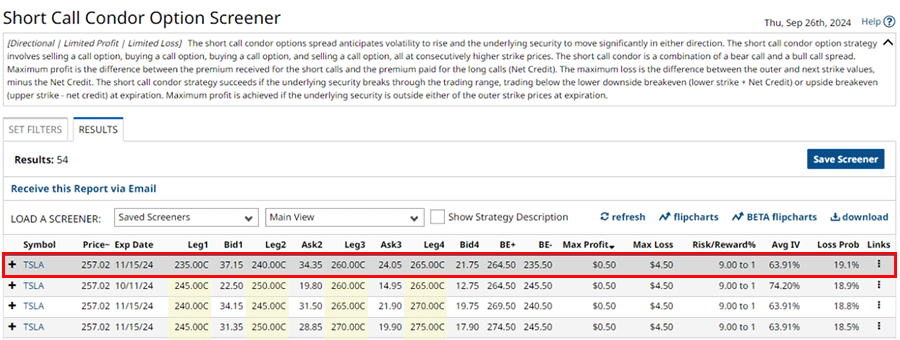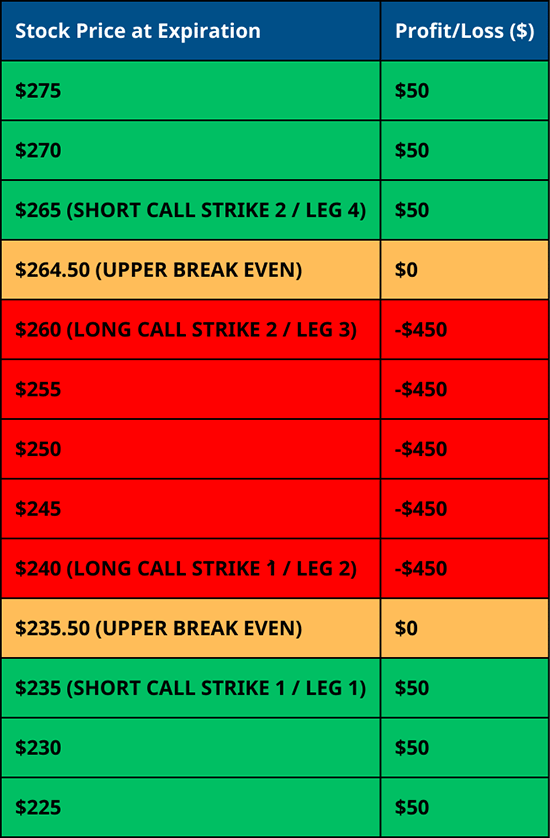Short Call Condor Option Strategy
Hi, and welcome to the Options Learning Center. I'm going to show you how to sell short call condors and use Barchart to get the most out of the strategy.
What is a Short Call Condor?
A short call condor spread is a directional options trading strategy that involves buying and selling four call options, each at progressively higher strike prices on the same underlying asset, and the same expiration date. The result is a combination of a bear call spread and a bull call spread and works best when you expect the underlying asset to have significant price movement.

Short Call Condor Options Strategy:
- Directional Strategy
- Four Call Options
- Same Underlying Asset & Expiration
- Results in a Bear Call & Bull Call Spread
- Profit If The Price Moves Beyond Short Strikes
- Requires Significant Price Movement
To setup the trade, you'll sell a call option at one strike, then buy a call at a higher strike, buy another at an even higher strike, and finally, sell a call at the highest strike.
Short Call Condor:
- Sell a Call: Lowest strike price.
- Buy a Call: At a higher strike price.
- Buy a Call: At an even higher strike price.
- Sell a Call: At the highest strike price.
The result is a combination of a bear call and bull call spread that creates a short call condor, resulting in a net premium, also known as a net credit.
To achieve maximum profit on the trade, the underlying asset needs to trade below the lower short strike or above the higher short strike at expiration. Maximum loss occurs if the underlying asset trades between the long strikes.
- Result: Combination of Bear Call & Bull Call Spread
- Max Profit: Asset Trades Beyond Short Strikes
- Max Loss: Asset Trades Between Long Strikes
Trade Examples
Looking for short call condor spreads in the market can be time-consuming. Thankfully, platforms like Barchart allow traders to screen the market for different options trading strategies.
Screening The Market For Short Call Condor Trades
To access the Short Call Condor screener, go to Barchart.com, click on the Options tab, and then click on Short Call Condor Screener. This will immediately bring you to the Results page, where you can find likely trades.
Here, you'll see all the trades that fit the default criteria for short call condors. You'll find information about the underlying assets, strike prices, premiums, profits and loss points, and the probability of loss. Each column can be rearranged from highest to lowest or vice versa by clicking on the column header. That makes it easier when you're looking for the best trade for a certain metric or condition.
Now, if you want a more customized search, look for the Set Filters tab at the top. Once you click that, you will be brought to the options screening page, where several default filters and values are already in place for short call condor trades.
If you want to add filters, you can easily do that by clicking in the Add a Filter field, typing in your preferred filter, then click Add. If you're not sure what filter you're looking for, you can also click the dropdown to choose from dozens of other filters.
To delete any of the filters, click the checkbox next to them and then click Delete. The default filters provide a healthy balance of opportunities. Of course, you can expand the search by adding in weekly expirations and ETFs.
Now, I'll scroll down to the bottom where I'll find the Probability of Loss filter. As the name suggests, this measures the chance of the trade losing money, even just a cent. So, it's a pretty good filter to consider. Lower probability of loss means lower potential profit, but a higher potential of loss in terms of dollars and cents. In this example I'll set it to less than 20% probability of loss, and click See Results.
We have quite a range of trades on the Results page. I'll now arrange the results from highest to lowest in terms of maximum profit, and pick the top one. Now, before we discuss the trade, I want to show you how to save your screener to reuse it later. Just click Save Screener near the top right, then type in the name of the screener. You can also have barchart email you with trades that match your filters on a daily basis - just click on when you want the email to arrive. It is that easy.
Let's move on to the trade example:

The first on the list is a short call condor on Tesla. The stock currently trades at $257.02. For the the bear call side of the trade, you'll sell a $235-strike call for $37.15 per share and buy a $240-strike call for $34.35 per share.
On the bull call side, you'll buy a $260-strike call and pay $24.05 per share, then sell a $265-strike long call for $21.75 per share. This trade results in a net premium of 50 cents per share, or $50 total, while your maximum loss is $4.50 per share. The trade has a 9 to 1 risk-reward ratio, and a 19.1% probability of loss, with all options expiring on November 15, or in 46 days from the time of recording.

Let's get the breakeven points on the upside and downside for easier trade calculations. To get the breakeven points on a short call condor, first add the net premium to the lower short call strike. For the upside, subtract the net premium paid from the higher short call strike. So, that makes the breakeven points $235.50 on the downside and $264.50 on the upside.
Breakeven Calculation:
- Downside: Lower call strike plus the premium received.
- Upside: Higher call strike minus the premium received.
And with those details, let's break down the trade.
Profit Scenario

If the price of Tesla moves beyond the short strike prices in either direction, you get to keep the maximum profit. The maximum profit is calculated by subtracting the premium paid from the premium received to set up the trade. To recap, for this trade, it's 50 cents or $50 per contract sold.
Premiums Paid: $34.35 + $24.05 = $58.40
Premium Received: $37.15 + $21.75 = $58.90
Net Premium: $58.90 - $58.40 = $0.50 * 100 = $50
Loss Scenario

If, however, Tesla stock does not experience any significant price movement before expiration, you enter the maximum loss condition for this short call condor. To calculate the maximum loss, take the difference between either of the spreads, which is $5 in this case, and subtract the credit received. That works out to $4.50 a share, or $450 per contract.
Width Of The Spread: $240 - $235 = $5
Net Premium Received: $0.50
Maximum Loss: $0.50 - $5 = -$4.50
Profit/Loss Scenarios Across Different Price Points
Here's a profit/loss chart with different prices at expiration to illustrate how short call condor trades work.

The profit zones begin just beyond the breakeven points, and maximum profit occurs when the stock trades above the short call strike on the upper end and below it at the lower end. And maximum loss will occur when the stock trades between the long call strikes.
Screening For Short Call Condors With Specific Assets
So far, you've learned how to scan the market for short call condor trades. But what about if you have a specific stock in mind? That's also easy. Let me show you how.
All you need to do is go to the stock or asset's Price Overview page on Barchart.com. Once there, look for Condor Strategies. Then look for the Short Call Condor tab. From here, you can change expiration dates, change trade legs, rearrange each column, or click the screen button to reach the option screener page for a more granular search. That's it!
Closing Your Positions Before Expiration
While the point of a short call condor is to achieve maximum profit, it's best practice to close your trades right before expiration to avoid assignment, especially if your options are in the money. For this example, you have two short positions in this trade, and if either of them is in the money at expiration, the option will be automatically exercised, or, in your perspective, you will be assigned.
- Close The Trade at Expiration
- Avoid Automatic Assignments
- Two Short Positions at Risk
Pros and Cons
Short call condors have limited risks, making them great for risk-averse traders. The profit conditions are also range-bound, meaning as long as the underlying price moves beyond the short strikes, you'll achieve maximum profit.
Pros:
- Limited Risk
- Range-Bound Profit
- Net Premium Strategy
However, short call condors, like all spreads, have limited profit potential, even more so compared to their long condor counterparts. Also, like most short spreads, have high risk-to-reward ratios, which means you can lose multiple times your credit. Finally, the strategy requires a highly volatile trading environment to turn a profit.
Cons:
- Limited Profit
- High Risk/Reward Ratio
- High Volatility Requirements
Conclusion
Short call condors can be an excellent way to get paid in volatile markets - as long as you find the right time and asset to use. It does have some drawbacks, like limited profitability and high risk-reward ratios, so it's best to utilize all available resources, including option scanners, to maximize your chance of success.
If you'd like more information, visit the Barchart Options Learning Center, where you can learn more about all the other options trading strategies, how they work, and how to profit from each.
Back to Top ↑